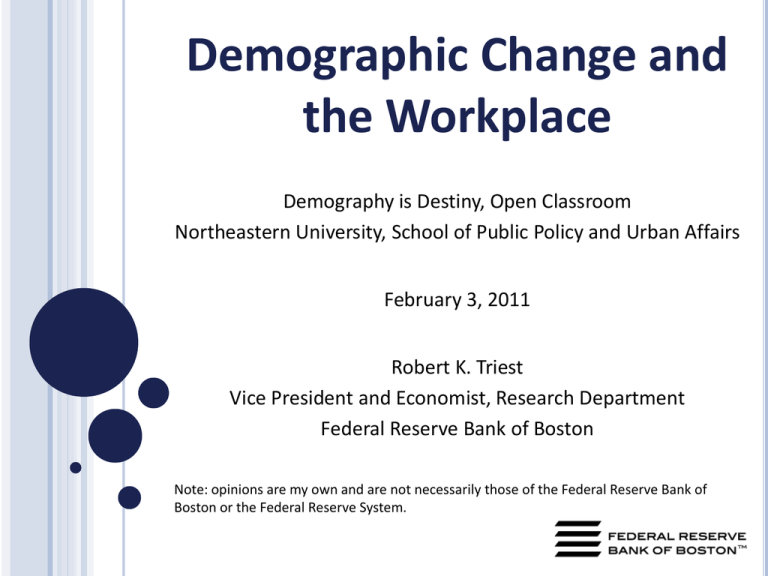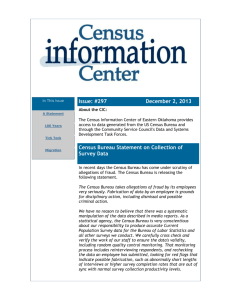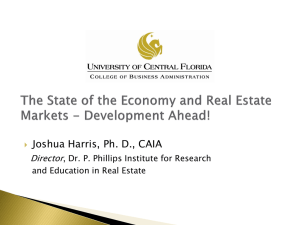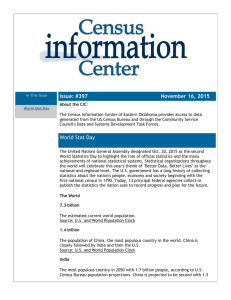Demographic Change and the Workplace
advertisement

Demographic Change and the Workplace Demography is Destiny, Open Classroom Northeastern University, School of Public Policy and Urban Affairs February 3, 2011 Robert K. Triest Vice President and Economist, Research Department Federal Reserve Bank of Boston Note: opinions are my own and are not necessarily those of the Federal Reserve Bank of Boston or the Federal Reserve System. Demographic change occurs slowly • “Demography as destiny.” • 2001 Boston Fed conference: – Seismic Shifts: The Economic Impact of Demographic Change – (available at www.bos.frb.org/economic/conf/conf46/) • Contrast with business cycle data: – Even current quarter GDP is hard to predict! Prof. Bluestone used TV shows as examples of changes in U.S. family structure. – Leave it to Beaver -to- Modern Family • Changes in U.S. workplaces as reflected on TV: – The Flintstones – -to- The Office The U.S. workforce has become: • More diverse – Dramatic increase in representation of women – Increased share of minority groups – Increased share of immigrants • Better educated – Increased rates of high school and college graduation. • Older – Increase in average age and a flattening of the age structure Female labor force participation has increased while male participation has decreased SA, % Labor Force Participation Rate: 16 Years & Over 100 90 80 70 60 50 40 Men Women Total 30 20 10 0 1948 1953 1958 1963 1968 1973 1978 1983 1988 Source: Bureau of Labor Statistics 1993 1998 2003 2008 Youth labor force participation has recently been trending downwards SA, % Labor Force Participation Rate: 16 - 19 Years 70 65 60 55 50 45 40 Men Women Total 35 30 25 20 1948 1953 1958 1963 1968 1973 1978 1983 1988 Source: Bureau of Labor Statistics 1993 1998 2003 2008 Convergence between genders in middle age participation rates SA, % 100 Labor Force Participation Rate: 45 - 54 Years 90 80 70 Men Women Total 60 50 40 30 20 1948 1953 1958 1963 1968 1973 1978 1983 1988 Source: Bureau of Labor Statistics 1993 1998 2003 2008 …with convergence continuing as retirement approaches. NSA, % Labor Force Participation Rate: 55 to 64 Years 100 90 80 70 60 50 40 Men Women Total 30 20 10 0 1948 1953 1958 1963 1968 1973 1978 1983 1988 Source: Bureau of Labor Statistics 1993 1998 2003 2008 Participation rates for 65-69 year olds are low but increasing. Labor Force Participation Rate: 65 - 69 Years NSA, % 40 35 30 25 20 15 Men Women Total 10 5 Source: Bureau of Labor Statistics 2010 2009 2008 2006 2005 2004 2003 2002 2001 2000 1999 1998 1997 1996 1995 1993 1992 1991 1990 1989 1988 1987 1986 1985 1984 1983 1982 0 …as is true of 70-74 year olds. NSA, % Labor Force Participation Rate: 70 - 74 Years 30 25 20 15 Men Women Total 10 5 0 1987 1990 1993 1996 1999 2002 Source: Bureau of Labor Statistics 2005 2008 High school graduation rates have increased dramatically over time. Percent of Population with a High School Diploma or Higher % 100 1960 90 1980 2000 80 70 60 50 40 30 20 10 0 25-29 30-34 35-39 40-44 45-49 50-54 55-59 60-64 65-69 Age Source: U.S. Census Bureau, Decennial Census of Population. 70-74 75+ College graduation has also become more common over time. Percent of Population with a B.A. or Higher % 35 1960 1980 2000 30 25 20 15 10 5 0 25-29 30-34 35-39 40-44 45-49 50-54 Age 55-59 60-64 65-69 Source: U.S. Census Bureau, Decennial Census of Population. 70-74 75+ 30 years ago, college graduation was more common among men than among women. Percent of Population with a B.A. or Higher, 1980 % 35 Men 30 Women 25 20 15 10 5 0 25-29 30-34 35-39 40-44 45-49 50-54 Age 55-59 60-64 65-69 Source: U.S. Census Bureau, Decennial Census of Population. 70-74 75+ Among young cohorts, college graduation is more common among women. Percent of Population with a B.A. or Higher, 2009 % 40 35 30 25 20 15 Men Women 10 5 0 25-29 30-34 35-39 40-44 45-49 50-54 55-59 60-64 65-69 Age Source: U.S. Census Bureau, Decennial Census of Population. 70-74 75+ Management education was formerly male dominated. Source: Claudia Goldin, “From the Valley to the Summit,” Regional Review, Federal Reserve Bank of Boston, Q1 2005 The share of women in many professional programs has increased dramatically. Source: Claudia Goldin, “From the Valley to the Summit,” Regional Review, Federal Reserve Bank of Boston, Q1 2005 Increased educational attainment is associated with: • Increased earnings. • Decreased unemployment rate. • Increased labor force participation rate. Median Earnings of Full-Time Year-Round Workers Ages 25–34, by Gender and Education Level, 1971–2008 (in Constant 2008 Dollars) Sources: The College Board, Education Pays 2010, Figure 1.6; National Center for Education Statistics, 2004; U.S. Census Bureau, 2003–2009; Bureau of Labor Statistics, 2010g; calculations by the authors. Slide from The College Board, “Education Pays 2010” Unemployment Rate by Educational Attainment 25+ Years (SA, %) 16 16 No high school diploma High school grads Some college College grads + 12 12 8 8 4 4 0 0 95 Sources: BLS /Haver 00 05 10 Labor Force Participation Rate by Educational Attainment 25+ Years (SA, %) 82.5 75.0 82.5 No high school diploma High school grads Some college College grads + 75.0 67.5 67.5 60.0 60.0 52.5 52.5 45.0 45.0 37.5 37.5 95 Sources: BLS /Haver 00 05 10 The labor force is becoming more racially and ethnically diverse. 1988 Asian 3% Hispanic, nonBlack 7% Other 2018 3% Black 11% Asian 6% White, nonHispanic 79% Black 12% Hispanic, nonBlack 15% Source: Bureau of Labor Statistics White, nonHispanic 64% The U.S. has entered an era of slow labor force growth. 3.00 Annualized rate, % 2.50 2.00 1.50 1.00 0.50 0.00 1950s 1960s 1970s 1980s 1990s 2000s 2010s 2020s Labor Force Growth Rate (16 years and over) Population Growth Rate (15 to 64 years) Source: Bureau of Labor Statistics, Census Bureau 2030s 2040s Changes in the age distribution • Reduced labor force growth may produce a general shortage of workers. – But the reduction in birth rates has also produced a flattening of the wage structure. – Will there be a surplus of older individuals who would like to continue working? Changes in the age distribution • The flattening of the wage structure has reduced the economic return to labor market experience. – Research from “Population Aging, Labor Demand, and the Structure of Wages,” joint work with Margarita Sapozhnikov.











